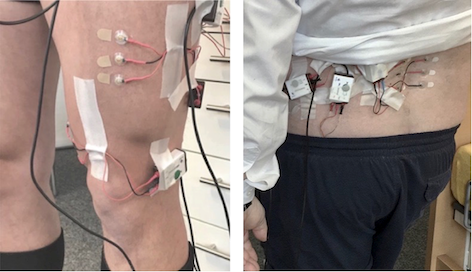Sensor-based identification of muscular burden on lower extremity of informal caregivers
Sensor-based identification of muscular burden on lower extremity of informal caregivers
Biomechanical analysis of caregiving scenarios
Motivation
Due to increased life expectancy, the socio-demographic development of Germany is leading to an imbalance between persons providing care and those in need of care. The demand for and number of informal caregivers in the home environment will inevitably increase to counteract this discrepancy and to strengthen the sustainability of German health care systems. In view of this, the relevance of physiological processes of informal caregivers regarding the musculoskeletal strains associated with the performance of care activities becomes evident. These are due to manually performed care processes as well as the resulting high compressive forces on the lumbosacral discs. Related diseases of the musculoskeletal system are the main risk factors for the development of back diseases. Older and especially informal caregivers have a generally reduced potential to compensate for the stresses and strains of everyday nursing care due to age-associated physiological changes and the associated reduction in physical functions.
In the context of informal care activities, biomechanical overloads are potential and require a functional approach to ergonomic caregiving, considering the age- and gender-specific physiology of the caregivers.
Approach
The scientific focus so far, in addition to the relief of caregivers through technical systems, has primarily been on the analysis of lumbar compression during manual caregiving. Although reference is made in this context to the relief function of the muscles of the lower extremity, a scientifically based analysis does not exist at the moment. The main goal of the project is the sensor-based identification of muscular burden on lower extremity of informal caregivers applying the following methods for measurement and analysis.
The use of various geriatric assessments (chair-rise, sit-to-stand, hand-grip strength, etc.) serves to systematically assess the functional status of informal caregivers. The observation of the assessment/caregiving processes is conducted under laboratory conditions using a measurement and analysis system. The data obtained is used to quantify the executed processes and to assess and evaluate them biomechanically. The methods for measurement and analysis are based on measuring the kinematics of the moving body and its segments, the generated force (kinetics) and the measurement of muscle activity during the execution of the assessments as well as in the caregiving context. An optical tracking system (multi-depth image camera system) records the data required for motion analysis in the form of a three-dimensional, interactive point cloud. The kinetics of the human body are based on the quantification of external ground reaction forces via piezoelectric sensors. The measurement of muscle activity is carried out using non-invasive surface electromyography (EMG). The EMG is used to record the electrical action potentials associated with a muscle contraction in order to gain information on the activation behavior of selected muscle groups in the assessments/caregiving activities. The estimation of muscle activity is based on the potential level and is set in relation to the time sequence of the activities as well as to the ground reaction forces generated within the context. On the one hand, the relevance of the lower extremity in the context of musculoskeletal burden in informal care should be identified sensor-based. On the other hand, the combination of the measurement and analysis system with geriatric assessments serves the predictive detection of functional degradation and the potential to provide informal care.

